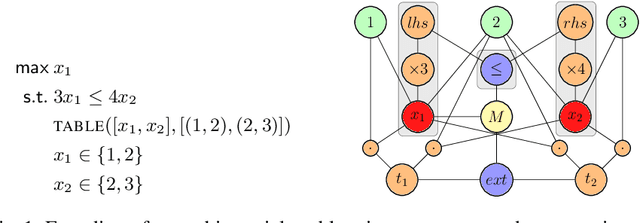Hélène Verhaeghe
CP-Model-Zoo: A Natural Language Query System for Constraint Programming Models
Sep 09, 2025Abstract:Constraint Programming and its high-level modeling languages have long been recognized for their potential to achieve the holy grail of problem-solving. However, the complexity of modeling languages, the large number of global constraints, and the art of creating good models have often hindered non-experts from choosing CP to solve their combinatorial problems. While generating an expert-level model from a natural-language description of a problem would be the dream, we are not yet there. We propose a tutoring system called CP-Model-Zoo, exploiting expert-written models accumulated through the years. CP-Model-Zoo retrieves the closest source code model from a database based on a user's natural language description of a combinatorial problem. It ensures that expert-validated models are presented to the user while eliminating the need for human data labeling. Our experiments show excellent accuracy in retrieving the correct model based on a user-input description of a problem simulated with different levels of expertise.
Exploiting Symmetries in MUS Computation (Extended version)
Dec 18, 2024

Abstract:In eXplainable Constraint Solving (XCS), it is common to extract a Minimal Unsatisfiable Subset (MUS) from a set of unsatisfiable constraints. This helps explain to a user why a constraint specification does not admit a solution. Finding MUSes can be computationally expensive for highly symmetric problems, as many combinations of constraints need to be considered. In the traditional context of solving satisfaction problems, symmetry has been well studied, and effective ways to detect and exploit symmetries during the search exist. However, in the setting of finding MUSes of unsatisfiable constraint programs, symmetries are understudied. In this paper, we take inspiration from existing symmetry-handling techniques and adapt well-known MUS-computation methods to exploit symmetries in the specification, speeding-up overall computation time. Our results display a significant reduction of runtime for our adapted algorithms compared to the baseline on symmetric problems.
Trustworthy and Explainable Decision-Making for Workforce allocation
Dec 13, 2024Abstract:In industrial contexts, effective workforce allocation is crucial for operational efficiency. This paper presents an ongoing project focused on developing a decision-making tool designed for workforce allocation, emphasising the explainability to enhance its trustworthiness. Our objective is to create a system that not only optimises the allocation of teams to scheduled tasks but also provides clear, understandable explanations for its decisions, particularly in cases where the problem is infeasible. By incorporating human-in-the-loop mechanisms, the tool aims to enhance user trust and facilitate interactive conflict resolution. We implemented our approach on a prototype tool/digital demonstrator intended to be evaluated on a real industrial scenario both in terms of performance and user acceptability.
Towards a Generic Representation of Combinatorial Problems for Learning-Based Approaches
Mar 13, 2024


Abstract:In recent years, there has been a growing interest in using learning-based approaches for solving combinatorial problems, either in an end-to-end manner or in conjunction with traditional optimization algorithms. In both scenarios, the challenge lies in encoding the targeted combinatorial problems into a structure compatible with the learning algorithm. Many existing works have proposed problem-specific representations, often in the form of a graph, to leverage the advantages of \textit{graph neural networks}. However, these approaches lack generality, as the representation cannot be easily transferred from one combinatorial problem to another one. While some attempts have been made to bridge this gap, they still offer a partial generality only. In response to this challenge, this paper advocates for progress toward a fully generic representation of combinatorial problems for learning-based approaches. The approach we propose involves constructing a graph by breaking down any constraint of a combinatorial problem into an abstract syntax tree and expressing relationships (e.g., a variable involved in a constraint) through the edges. Furthermore, we introduce a graph neural network architecture capable of efficiently learning from this representation. The tool provided operates on combinatorial problems expressed in the XCSP3 format, handling all the constraints available in the 2023 mini-track competition. Experimental results on four combinatorial problems demonstrate that our architecture achieves performance comparable to dedicated architectures while maintaining generality. Our code and trained models are publicly available at \url{https://github.com/corail-research/learning-generic-csp}.
Holy Grail 2.0: From Natural Language to Constraint Models
Aug 03, 2023Abstract:Twenty-seven years ago, E. Freuder highlighted that "Constraint programming represents one of the closest approaches computer science has yet made to the Holy Grail of programming: the user states the problem, the computer solves it". Nowadays, CP users have great modeling tools available (like Minizinc and CPMpy), allowing them to formulate the problem and then let a solver do the rest of the job, getting closer to the stated goal. However, this still requires the CP user to know the formalism and respect it. Another significant challenge lies in the expertise required to effectively model combinatorial problems. All this limits the wider adoption of CP. In this position paper, we investigate a possible approach to leverage pre-trained Large Language Models to extract models from textual problem descriptions. More specifically, we take inspiration from the Natural Language Processing for Optimization (NL4OPT) challenge and present early results with a decomposition-based prompting approach to GPT Models.
 Add to Chrome
Add to Chrome Add to Firefox
Add to Firefox Add to Edge
Add to Edge